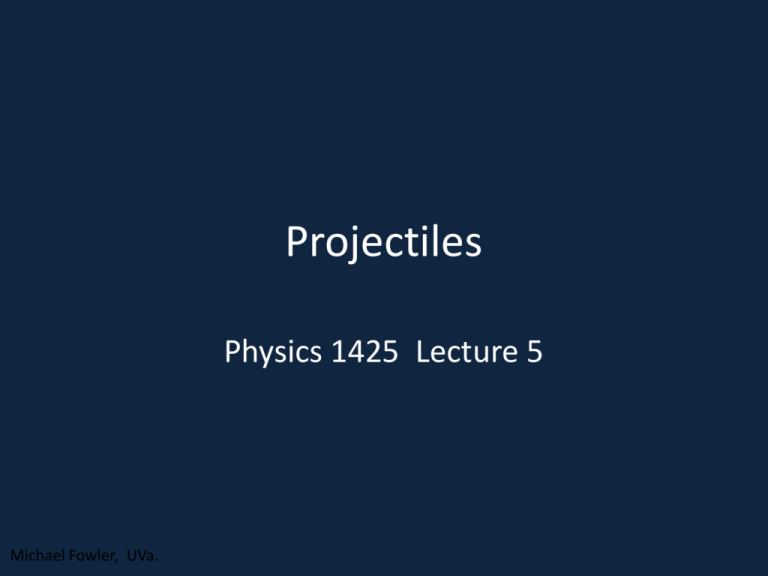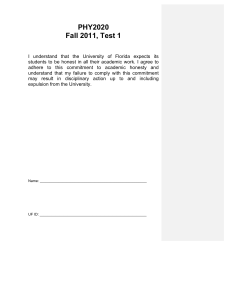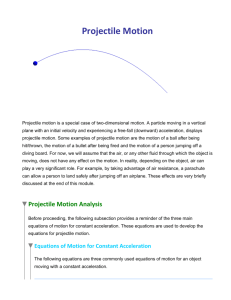5. Projectile Motion - Galileo and Einstein
advertisement

Projectiles Physics 1425 Lecture 5 Michael Fowler, UVa. Reminder: Galileo’s Laws of Motion • Neglecting air resistance and friction, Galileo claimed: 1. Horizontal motion: (ball rolling on table) an object would continue to move at constant velocity unless pushed. 2. Vertical motion: a falling body would accelerate downwards at a uniform rate. Galileo’s Law for Projectiles • He asked himself: what would happen if the ball rolled off the table? • He claimed (and established experimentally) that the balls uniform horizontal motion would continue as before – • BUT natural vertical falling motion would be added! • He termed the result “compound motion”. Here’s Galileo’s own picture … and here’s a link to an animation. Equation for the Trajectory • Taking t = 0 to be when the ball rolls off the edge, and the origin O at that point, x = v0 xt y = − gt 1 2 from which y = − ( g / 2v 2 0x 2 )x . 2 The standard parabola equation is y = ax2, so this is half of an upside-down parabola. Clicker Question • Suppose that as the ball rolling across the table goes over the edge, it touches another ball that was just balanced on the edge. Assume the first ball’s trajectory is not changed, the second ball falls vertically down. A. The rolling ball hits the ground first B. The dropping ball gets there first C. They hit the ground at the same time Car Goes Horizontally Over Cliff • Position at 1 second intervals (v0 = 20 m/s) • Velocities and Speeds at 1 second intervals: • g=0 trajectory in red • Taking g = 10, positions are (0, 0), (20, -5), (40, -20), (60, -45). • Speeds are approx: 20, 22, 28, 36 m/s. Full Projectile Path • A projectile is shot at some upward angle from the origin: see animation. • Galileo tells us the horizontal motion is just steady velocity, the vertical motion is the same as that of a ball thrown directly upwards. • Therefore = x v t ,= y v t − 1 gt 2 . 0x 0y 2 • Eliminating t gives a parabolic curve through O: = y (v 0y / v0 x ) x − ( g / 2v 2 0x )x . 2 Vector Picture of Projectile Motion 2 1 = r v0t − 2 gt r = v0t Position at 1 second intervals (notice it falls below straight line: the g =0 trajectory). Velocities and Speeds at 1 second intervals. Hang Time • How long does it take the ball to go up and come back down again? • Initial upward velocity v0y, upward velocity changes by –g each second, back down at –v0y, so gt = 2voy • Hang time: t = 2v0 y g http://curlyr.blogspot.com/2008_09_01_archive.html Range A • Given the initial velocity v0 = ( v0 x , v0 y ) The Paris gun, used by the German army to shell Paris in 1918. Its range was about 80 miles, 130 km. • The hang time is t = 2v0 y / g and during that time the shell travels a horizontal distance = R v= 2v0 x v0 y / g . 0 xt • This is the range. http://en.wikipedia.org/wiki/File:Parisgun2.jpg Maximum Range A • Taking the muzzle velocity v0 as fixed, how do we vary the angle of firing θ to maximize the range? • Now • So R v0 x http://www.edupics.com/humancannon-t10746.jpg v0 v= v0 sin θ 0 cos θ , v0 y 2= v0 x v0 y / g 2 ( v02 / g ) sin θ cosθ = ( v / g ) sin 2θ 2 0 • And maximum range Rmax = v / g at 45° 2 0 θ











